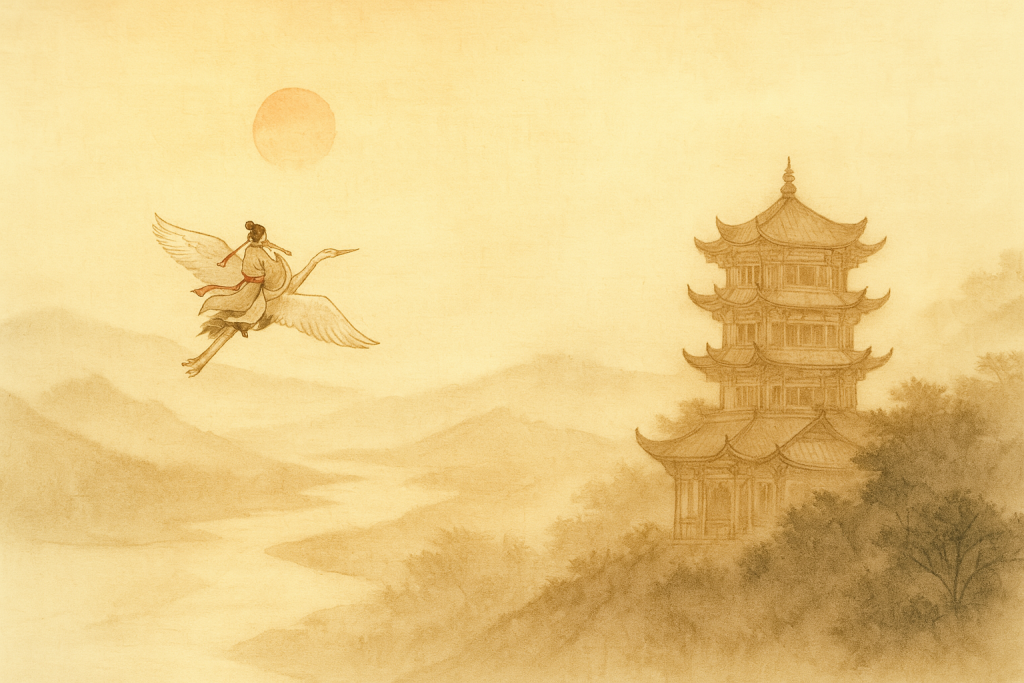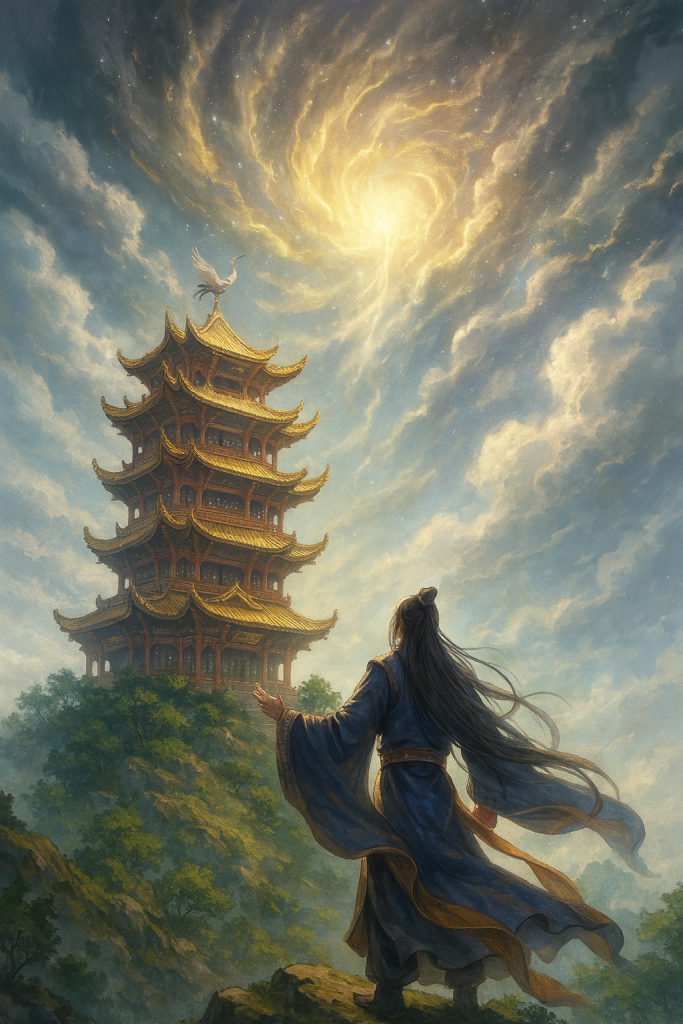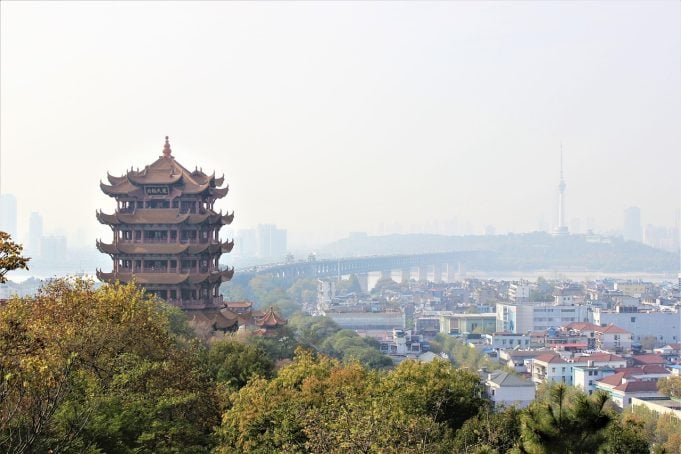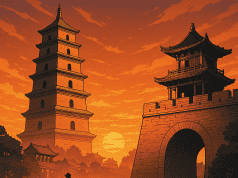Egy torony, ahol a föld és az ég összeér…lehetne ez is akár a mai bejegyzésem címe és még csak nem is lenne akkora nagy költői túlzás.
A Sárga Daru Torony (黄鹤楼) Kína négy nagy „tornyának” az egyike.
A Sárga Daru a Jangce folyó partján áll és lenyűgöző kilátást nyújt Vuhan városára.
Ezen a helyen a kínai történelem, a költészet és a legendák összeolvadnak.
Ebben a posztban most megmutatom Nektek, hogy miért is hívják a halhatatlan történetek tornyának! 😉
Eredetileg Kr. u. 223-ban emelték a Sárga Daru elődjét, amely az évszázadok során számos alkalommal újjászületett.
A ma látható változat 1981 és 1985 között épült fel: 51,4 méter magas, és 3219 négyzetméternyi területet birtokol.
A jelenlegi torony a festői Kígyó-dombon emelkedik, nagyjából egy kilométerrel odébb attól a helytől, ahol az eredeti állt.
A torony halhatatlan legendája:
A legenda szerint egykor élt egy Xin nevű vendéglős a későbbi torony környékén. Egy igen szegénynek tűnő bölcs vándor / tanító nap mint nap betért hozzá borért – fizetség nélkül. Xin azonban sosem küldte el.
Fél év után a vándor így szólt: „Tartozom neked, de pénzem nincs.” Narancshéjjal(egyes változatok szerint citromhéjjal…igen, elég sok legenda-változattal találkoztam szóval kicsit sikerült a végére összezavarodnom) rajzolt egy darut a falra, majd azt mondta: „Tapsolj, és táncolni fog.” A daru valóban életre kelt, táncolt és onnantól fogva csodát láthatott minden vendég aki Xin vendéglőjébe betért.
Xin híres és gazdag lett, a vendéglője nagyon népszerűvé vált. Évek múlva a vándor visszatért a nagyon hálás Xinhez. Fuvolát vett elő a titokzatos férfi és játszani kezdett – felhők szálltak alá egy daru lépett elő és a férfit a hátára véve a mennybe repült.
Xin hálából tornyot emelt az általa halhatatlannak vélt taoista emlékére, méghozzá pontosan ott, ahol a daru felszállt a férfival az Ég felé.

Illusztráció / kép: Furulyázó férfi darun reppenve.
Saját kép, én terveztem egyéb program segítségével
Így született hát meg a Sárga Daru Torony legendája és neve…bár valószínűleg inkább a Sárga Daru mólóról kapta a torony a nevét, de ez már egy másik történet, nekem a legendák mindig jobban tetszettek, mint a „száraz tények” 😊
Nem csak ez az egy legenda kapcsolódik ám a domhoz / toronyhoz.
A másik szerint Fei Yi, Shu híres régense is itt vált halhatatlanná és azóta is egy sárga daru hátán szeli az eget és útjai során gyakran ereszkedik le a Kígyó-dombra, hogy megpihenjen a földi csend ölén.
A legendák szerint Lü Dongbin is épp innen emelkedett a mennybe. A domb mélyén kis barlang húzódik, ahol Lü Dongbin szobra őrzi a történet emlékét. E barlangot „Lü Dongbin barlangjának” hívják.
A torony gyakorlatilag a taoizmus egyik szent helyének is tekinthető.
A torony legendái, léte, szépsége sokakat megihletett.
A Sárga Daru Toronyról írt verseket többek között Cui Hao, Li Bai és még Mao Ce-tung is.
A legendák és a gyönyörű versek által a torony is „halhatatlanná” vált.
Bár a történelem során sok viszontagság sújtotta (tűzvész és háborúk) és ma már „csak” az utódja áll az eredeti toronynak, de ez az utód büszkén dacol az idővel és méltó emléket állít az elődjének.
A torony napjainkban:
A Sárga Daru Torony ma egy igazi turistalátványosság, amit mindenkinek látni kell.
A torony belépőjeggyel látogatható.
A torony tetejéről lenyűgöző kilátás nyílik a Jangce folyóra. Bár a jelenlegi épület modern anyagokból készült, megidézi az eredeti torony hangulatát – még lift is van benne. Minden szinten külön kiállítás várja a látogatókat.
A torony mellett Yue Fei szobra áll.
A Sárga Daru Torony hivatalosan is elnyerte a Kínai Nemzeti Turisztikai Hivatal legmagasabb, AAAAA minősítését, mint kiemelkedő turisztikai látványosság.
A poszt zárásként álljon pedig itt Cuī Hào (崔颢) időtlen költeménye melynek sorai akár a szél ma is körbejárják a tornyot és a dombot, „susognak” a Jangce fölött és megérintenek minden ideérkezőt.
Aki egyszer felkeresi e helyet álljon meg pár percre, csendesedjen el és hagyja, hogy a csend és a hely meséljen neki.
Meséljen múltról, halhatatlanokról, építészetről, vallásról és egy festő hely békéjéről.
„Réges-régen elment valaki a sárga daru hátán,
csak a torony maradt mögötte.
A daru többé nem tér vissza,
a felhők ezer éve tétova vendégek az égen.
A tiszta folyó tükrözi Hanyang fáit,
és a Papagáj-sziget illatos fűvel borított.
Alkonyatkor merre van az otthon?
A ködös Jangce-parton csak a bánat válaszol.”
Eredeti vers:
昔人已乘黃鶴去, 此地空餘黃鶴樓。
黃鶴一去不復返, 白雲千載空悠悠。
晴川歷歷漢陽樹, 芳草萋萋鸚鵡洲。
日暮鄉關何處是, 煙波江上使人愁。
* A poszthoz tartozó kép forrása: PIXABAY, a kép készítője / feltöltője pedig: „larcomar”.
#SárgaDaruTorony #Vuhan #KínaiLegendák #KínaiÉpítészet #HalhatatlanTörténetek #ÁzsiaiKultúra #Taoizmus #Jangce #KínaiUtazás #ŐsiKína #Műemlékvadász #Építészet #Turizmus #Utazás
ENGLISH TEXT:
The Tower of Immortal Stories – in the Footsteps of the Yellow Crane (黄鹤楼, Wuhan, China)
A tower where earth and sky meet…
That could easily be the title of today’s post – and it wouldn’t even be such a poetic exaggeration.
Why?
Well, you’ll see in the post below! 😉
The Yellow Crane Tower (黄鹤楼) is one of the four great towers of China.
Standing on the banks of the Yangtze River, it offers a stunning view of Wuhan, the capital of Hubei Province.
It’s a place where Chinese history, poetry, and legend merge into one.
In this post, I’ll show you why it’s called the tower of immortal stories.
The original tower was built in 223 AD, and over the centuries, it was destroyed and rebuilt many times.
The current version, standing today, was constructed between 1981 and 1985.
It rises 51.4 meters high and covers an area of 3,219 square meters.
It stands atop the scenic Snake Hill, about a kilometer away from its original site.
The Immortal Legend of the Tower:
As legend has it, a man named Xin once ran a small tavern near the current tower site.
A poor-looking wise traveler came in every day asking for wine – never paying. Yet Xin never turned him away.
Half a year later, the traveler said:
„I owe you much, but I have no money to repay.”
He took a piece of orange peel, drew a crane on the wall, and said:
„Clap your hands when guests arrive – and the crane will dance.”
And it did. The crane came alive, danced, and soon made Xin’s tavern famous.
Years later, the traveler returned. Xin thanked him and offered help – but the man only smiled, pulled out a flute, and began to play.
Clouds descended. The crane stepped from the wall, and together they rose into the sky.
Xin, believing he had met an immortal, built a tower on that very spot in his honor.
And so the Yellow Crane Tower was born.

Original image concept by me, created with the assistance of generative software.
(Of course, the name likely comes from the nearby “Yellow Crane Wharf” – but honestly, I’ve always preferred legends to „dry” facts. 😄)
And this isn’t the only story tied to the tower.
Another legend says that Fei Yi, a famous regent of Shu, also became immortal here – and now rides the skies on a yellow crane, often descending to rest upon Snake Hill in peaceful silence.
The tower is also a sacred site in Taoism: tradition says Lü Dongbin ascended to the heavens from here as well.
A small cave at the base of the hill holds his statue – it’s known as Lü Dongbin’s Cave.
The legends, the presence, and the beauty of the tower have inspired many.
Poets like Cui Hao, Li Bai, and even Mao Zedong wrote about it.
And through their verses, the tower itself became “immortal.”
Although war and fire ravaged it through the ages, and today’s structure is only a successor, this modern tower proudly defies time – and honors its legendary past.
The tower today:
The Yellow Crane Tower is now a must-see attraction.
Accessible by ticket, it offers breathtaking views of the Yangtze River from the top.
Though built from modern materials, it recreates the atmosphere of the original – and yes, there’s even an elevator.
Each floor houses a unique exhibition.
Next to the tower stands a statue of Yue Fei, marking the site’s historic military past.
The site has officially received the AAAAA rating from China’s National Tourism Administration – the highest recognition for scenic spots.
To close, let me share Cui Hao’s timeless poem – lines that still circle the tower like the wind, whispering over the Yangtze, brushing gently against anyone who comes here.
If you ever find yourself in this place, pause.
Let the silence speak.
It will tell you of the past, of immortals, of architecture, of faith, and of the deep peace that lives on this hill.
“Long ago, someone left riding the yellow crane,
Only the Yellow Crane Tower remains.
The crane has gone, never to return,
While clouds drift aimlessly for a thousand years.
The river reflects the trees of Hanyang,
And fragrant grasses grow lush on Parrot Island.
At sunset – which way leads to my homeland?
By the misty Yangtze, only sorrow answers.”
Original poem (by Cui Hao):
昔人已乘黃鶴去, 此地空餘黃鶴樓。
黃鶴一去不復返, 白雲千載空悠悠。
晴川歷歷漢陽樹, 芳草萋萋鸚鵡洲。
日暮鄉關何處是, 煙波江上使人愁。
*PICTURE SOURCE: PIXABAY – „larcomar”.
Illustrations: My work.
Mindig mosolygós, folyton álmodozó lány beleveti magát az épsztorik világába, amit meg is akar mutatni a világnak (de Magyarországnak mindenképpen). Mi rossz sülhet ki ebből? 🙂







